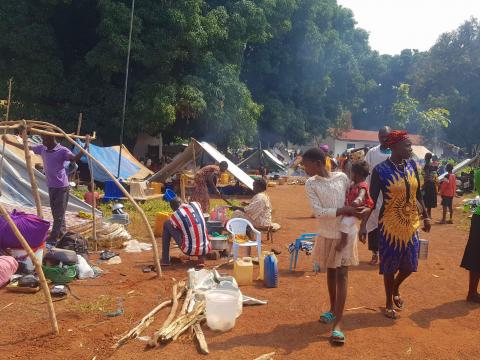World Vision's Tambura response assists over 36,000 displaced by clashes

The conflict and ensuing insecurity in Western Equatoria State’s Tambura and Ezo counties drove thousands of people into displacement and in makeshift camps where children are at risk of various diseases.
"The situation in Tambura is heartbreaking, with huge needs for water, sanitation and hygiene, health, nutrition and food assistance”, says Simanga Ndebele, Zonal Programme Manager of World Vision’s Western Equatoria Zone.

The World Vision emergency team found it hard to provide immediate health services due to lack of drugs and facilities, and the difficulty in deployment of support teams able to respond to the massive need.
Ndebele adds, “World Vision’s team on the ground are overwhelmed, but do our best to deliver the humanitarian services.” The threat to humanitarian workers is high heightened by the reported killing of health staff in one facility.
The situation in Tambura is heartbreaking, with huge needs for water, sanitation and hygiene, health, nutrition and food assistance.
In partnership with the World Food Programme (WFP), World Vision has distributed food assistance totalling to 216.849 Mt distributed to 36653 IDPs in Tambura, Ezo and Yambio counties.

The assistance were 77.215 metric tons (MT) of assorted food items for 20,735 people in Tambura County, followed by 65MT for 7,413 people in Ezo, and 74.634 distributed to 8505 people in Yambio.
In Ezo IDP camp, 8,413 people were verified along with 2,348 in Nzara, and now waiting for the distribution activity. Beeyo Simon, Food Assistance Project Manager said the road access and insecurity are major hurdles in the emergency response.

"We are concerned of the condition of children in the camps. Even cooking the food is a challenge for mothers who cannot gather firewood for fear of their safety. Deliveries of food supply face a lot of challenges especially with the bad roads and the distance", Simon says.
The nutrition screening resulted to 1,326 children aged 6-59 months with varying degrees of malnutrition status with 15 of them found with severe acute malnutrition.

Fifty-nine pregnant and lactating women were also screened of acute malnutrition. The 507 pregnant and lactating women also received 2.7495MT of CSB++ supplies.
“We need to keep our promise to every woman and child that we will be there to provide life saving interventions”, Ndebele conclude.

Related Story: Clashes in Western Equatoria State drive thousands to makeshift IDP camps
Story by Cecil Laguardia, Senior Manager for Advocacy and Communications I Photos by Western Equatoria Team